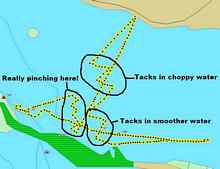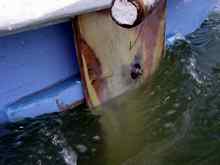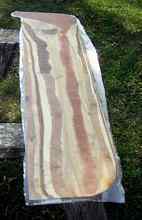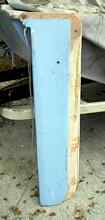
 Custom Search
|
|
| sails |
| plans |
| epoxy |
| rope/line |
| hardware |
| canoe/Kayak |
| sailmaking |
| materials |
| models |
| media |
| tools |
| gear |
 |
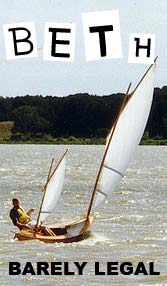 |
| join |
| home |
| indexes |
| classifieds |
| calendar |
| archives |
| about |
| links |
| Join Duckworks Get free newsletter Comment on articles CLICK HERE |
|
|
| Time for a New Leeboard |
by Gary and Helen Blankenship - Tallahassee, Florida - USA |
| I wish I had begun this "experiment" with some formal observations; then there would be something more to go on than my impressions. As it is, I'll leave the drawing of conclusions from this trial to others. I'm not much of a theoretician. The genesis for this project came from an observation from designer Jim Michalak. In one of his writings he recounted that enlarging the leeboard of his Piccup pram yielded a dramatic improvement in windward performance. I wrote Jim and asked how much longer he made his board and got a reply that he didn't make it longer, just wider. A Piccup is an 11-foot by 4.5-foot pram whose stout hull floats a host of small boat virtues. Easily built from five sheets of plywood, it has a good turn of speed for such a short boat, is stable, and maneuvers sharply. It rows well if you like to row. The covered end compartments provide both dry storage and floatation. It's a bit heavy for casual car-topping, but can be easily loaded into the back of a large van or a pickup truck (hence the name) or alternatively is a snap to launch from the lightest trailer from any ramp or beach where the wheels can touch the water. I bought the plans because it would fit into the back of a van I had at the time By the time it was built, I had another van and the Piccup was a couple inches too wide. Oh, well. A cheap used trailer does just fine. It's a wonderful impulse boat because it can be launched, rigged, and away sailing in about five minutes. The biggest drawback is the boat isn't close-winded, even by generous standards. My guess is the tacking angle was more than 120 degrees and it took close attention to get that. Here's were I wish I had taken more careful observations. But I don't have a compass on the Piccup and seldom bothered with a GPS, since it's used on lakes and bays with plenty of visual references. It's always been a boat for relaxed sailing so I never took it out with the goal of documenting its windward abilities. The Piccup is used a fair amount on a nearby small lake, which is surrounded by trees and low hills. Those make the wind unsteady in direction, so the tendency is to sail a bit further off the wind to compensate and sometimes it seems difficult to make any windward progress in the Piccup. On the list of boat projects for this year was a sprucing up of my Piccup. It's 15 or 16 years old now and while structurally sound the hull paint is peeling and the decks have checked a bit (it's built from BC pine ply). It seemed a logical time to retrofit a larger leeboard; and actually that was the first job tackled. The original leeboard is 47 inches long and tapered from 9 inches wide at the top to 7 inches wide at the bottom, and is ¾-inch thick. An examination of the mounting brackets, especially the upper leeboard guard, showed that the board would be widened by about 3 inches without having to modify that upper guard, as long as the extra width was added to the forward side of the board. (I didn't worry about what this would do the the balance under sail since it should shift the balance point only an inch or so, and it would be shifted forward which would help the slight lee helm I get in lighter winds.) There also was enough clearance in the upper guard to make the board a tad thicker, if desired. I made the new board 48 inches long, simply because that's the width of a sheet of ply, and tapered it from 12 inches at the top to 10 inches at the bottom. Four layers of Ultraply XL underlayment came out to a hair over ¾ inch. Still room for a layer of glass on each side after shaping. Thanks to my power planer, there's no question that the new board has a much better foil shape than the first version. After glassing and fairing, I decided to bolt the new board on before painting for a test. No sense painting if more modifications turned out to be needed. The last sail with the old board had been about a month previous in nearly ideal Piccup conditions; 12-15 mph of wind with some higher puffs. The boat powered along, rarely doing less than 4 knots and sometimes doing more than 5 - pretty good territory for a Piccup. Tacking was sure and reliable, but the pointing was nothing to write home about. No observations were taken, but it was well over 90 degrees. The test for the new board was in more benign conditions, unfortunately. The wind varied between about 4 and 11 mph, and was a bit shiftier in direction than the earlier outing.
And here are my initial observations and conclusions. Without any doubt the new leeboard has made the Piccup significantly closer winded. I also have the impression that leeway has been reduced -not surprising for a larger board -but probably a few more trips are in order to be sure. It initially seemed like the boat was taking on a near 90-degree angle, but that was deceptive. An examination of the GPS track from the outing is instructive. About halfway across Alligator Harbor (on the Florida Gulf coast, and an excellent place for small boats) in somewhat choppy water, the boat was on a course of 201. After a tack, the course was 94 degrees, for a tacking angle of 107. Not too bad for choppy water. A few minutes later, I tacked again and the course was 187 degrees, or a tacking able of 93 degrees. That's pretty impressive for a short, beamy boat with a balanced lug rig. These are actual course figures, so leeway is included. Probably the true tacking angle was between those two figures. I did several shorter tacks (my GPS was set up to record the track at three-minute intervals; too long to help on these tacks) and in the oscillating winds the tacking angle varied between 90 and around 105 on the GPS compass. I was closer to shore and in calmer water for these observations. But it reinforced the initial impression that the tacking angle is now around 100 - 110 degrees (and an easily maintained 100 - 110 degrees) instead of more than 120 degrees that required some concentration. Another noticeable change was the ability to pinch up on the wind. With the old board the boat wouldn't pinch at all. Point too close to the wind, and the boat stopped. With the new foil, I could sheet in more than before and point higher, although at a noticeable loss of speed. (We're talking about pointing closer than 50 degrees to the wind here.) For maximum velocity made good to windward, footing off to 50 degrees or so (the 100 degree tacking angle) seems to be about best, but it's nice to know in a tight spot the boat will do better, albeit at a penalty to speed. A few more trips will give a better feel for this as well. Handling of the boat was unchanged. It still tacked quickly and precisely and remained highly maneuverable. A second outing a few weeks later, in a bit stronger winds gave some more data. This time I got smart and reset the GPS to mark the track every 20 seconds so more tacks could be recorded and analyzed. In the middle of the bay, in slightly choppy water the tacks ran 100-120 degrees. The end of the boom was over the stern quarter of the boat, about where I usually like it for working close hauled. The boat could be made to point higher, but was happier not being pinched as the extra power helped punch through the chop. The improvement from the old leeboard was great enough that I had the impression we were doing 90-degree tacks, and had to check the GPS compass to make sure we hadn't pulled off that bit of magic. When we got to calmer water, I sheeted the sail so the boom was a few inches inboard of the stern quarters. Now we pulled tacks of 105 to 110 degrees. A little later I cranked the sheet in as far as I could to she how much would be squeezed out. The boat went noticeably slower thus pinched, but the tacks were 100 to 105 degrees. They look almost square on the GPS track. Again, all these readings include whatever leeway exists but this second sail reinforced the initial impression that leeway is dramatically reduced. I had no problem close hauled passing close to the windward side of poles and channel markers where with the old leeboard I wouldn't have chanced it. That is a definite gain! If you're addicted to numbers, here's some to consider. Michalak has written that a keel, leeboard, or centerboard should be around four percent of the boat's sail area. By my quick calculation, the immersed section of the old leeboard was almost exactly four percent of the sail area. (Michalak now prescribes a 68 or 70 square foot sail for the Piccup. Mine is his original specification, a 55 square foot sail which is a bit small in light winds.) Calculations put the new board at about 5.4 percent of the sail area. Theoretically (so the experts say) longer boards should help more than wider ones but I guess extra area is extra area. The Piccup now has roughly the same windward characteristics of our Frolic2, Oaracle. It's leeboard, by the same calculations, is about 4.4 percent of the sail area. I don't think enlarging it would give the kind of improvement seen on the Piccup. At least I don't plan to try anytime soon. A Caprice, the larger sister of the Frolic2, the leeboard is about 4.2 percent, and Michalak has recorded that it tacks in about 100 degrees. I'm not drawing any technical conclusions. My knowledge of the interplay between rig, hull shape, sail shape, foils, and the like is too sketchy. But it would be interesting to hear the thoughts of others, particularly if anyone has tried similar experiments. One non-technical conclusion is this: It is always a source of satisfaction to try a modification and find it noticeably improves the performance of an already highly pleasing boat. |

